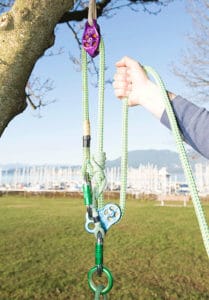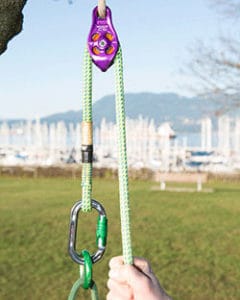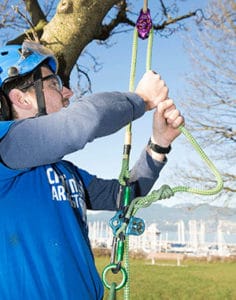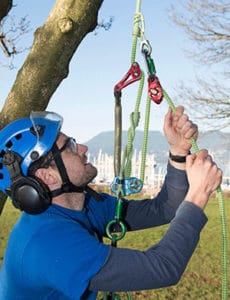First and foremost let me say that I have never been, nor am I, a wealth of knowledge when it comes to mechanical advantage with ropes and pulleys especially when systems start getting complicated. So I welcome all feedback and other points of view.
The reason I decided to write this article is because over the last few years each time somebody mentions MRS (Moving rope system) being a 2:1 MA (mechanical advantage) or SRS (Stationary rope system) being 1:1 MA it automatically presses the ‘On’ button in the mechanical advantage section of my brain, because I feel it is not quite right. So I decided to do a bit of research.
 Before I start explaining my thoughts on this subject, I’d like to say that it doesn’t change how hard or easy climbing is in the real world, it is merely food for thought, and making sure we are well informed and use the correct terminology.
Before I start explaining my thoughts on this subject, I’d like to say that it doesn’t change how hard or easy climbing is in the real world, it is merely food for thought, and making sure we are well informed and use the correct terminology.
I will begin with this image of a standard MRS setup, using one rope passing through a pulley doubled over, then connected back together with a friction hitch and carabiner with the addition of a micro pulley under the hitch for ease of tending slack. Now, in theory and real life if the tail of the rope is pulled upwards against the micro pulley then this appears to me to be a 3:1 MA system. As tree climbers we don't climb like this because trying to pull the tail upwards uses weaker muscles and can't generate as much force, but I’m sure those climbers that have used this method to lift a casualty in an aerial rescue scenario can attest to this seeming much easier.
 On the left is a picture of a rope passing through a pulley, which in Mechanical advantage terms is a 1:1 because there is no advantage gained when lifting a weight if the hauler is on the ground, the only purpose of that pulley is to change the direction in which the weight is being lifted/pulled from.
On the left is a picture of a rope passing through a pulley, which in Mechanical advantage terms is a 1:1 because there is no advantage gained when lifting a weight if the hauler is on the ground, the only purpose of that pulley is to change the direction in which the weight is being lifted/pulled from.
If we now look at the image below of the MRS climbing system being used by the tree climber to ascend, the way in which we use the system appears to revert it back to a basic change of direction. The one difference, that makes all the difference, is that in a tree climbing system the hauler is also the load and this changes everything. In this system climbing when the climber is on the ground with a 50ft tie in point there is 100ft of rope in the system, if the climber climbs to his/her tie in point they have pulled through/passed 100ft of rope to get there giving a 2:1 mechanical advantage. If that same climber was pulled up to their tie in point by a ground person, that ground person would only pull 50ft which would mean a 1:1 mechanical advantage.
 Lets move then to the SRS configuration, as climbers we physically climb up the fixed rope using devices designed for this application, meaning we make greater progress much quicker utilizing our legs unlike MRS where we primarily use our arms. If you think about the rope itself it isn’t moving, if the rope is fixed then there can be no mechanical advantage theory applied, in the same way we don’t apply this theory to climbing a set of ladders. The only ’mechanical advantage’ we have as climbers are the mechanical tools we utilize e.g. rope ascenders.
Lets move then to the SRS configuration, as climbers we physically climb up the fixed rope using devices designed for this application, meaning we make greater progress much quicker utilizing our legs unlike MRS where we primarily use our arms. If you think about the rope itself it isn’t moving, if the rope is fixed then there can be no mechanical advantage theory applied, in the same way we don’t apply this theory to climbing a set of ladders. The only ’mechanical advantage’ we have as climbers are the mechanical tools we utilize e.g. rope ascenders.
 When making a difficult limb walk maybe on a sloping limb a prusik/rope grab/ascender can be placed above the climbers friction hitch the the tail of the rope passed up and through a carabiner or pulley and back to the climber. When returning from the limb walk if the climber pulls on the tail coming from above him this appears to create a 2:1 MA if the hauler of the rope was stationary, but the hauler is also the load, so the M:A becomes a 3:1.
When making a difficult limb walk maybe on a sloping limb a prusik/rope grab/ascender can be placed above the climbers friction hitch the the tail of the rope passed up and through a carabiner or pulley and back to the climber. When returning from the limb walk if the climber pulls on the tail coming from above him this appears to create a 2:1 MA if the hauler of the rope was stationary, but the hauler is also the load, so the M:A becomes a 3:1.
Definition of Mechanical advantage:
Ratio of effort/force applied (input), to the force being applied to the load (output).






